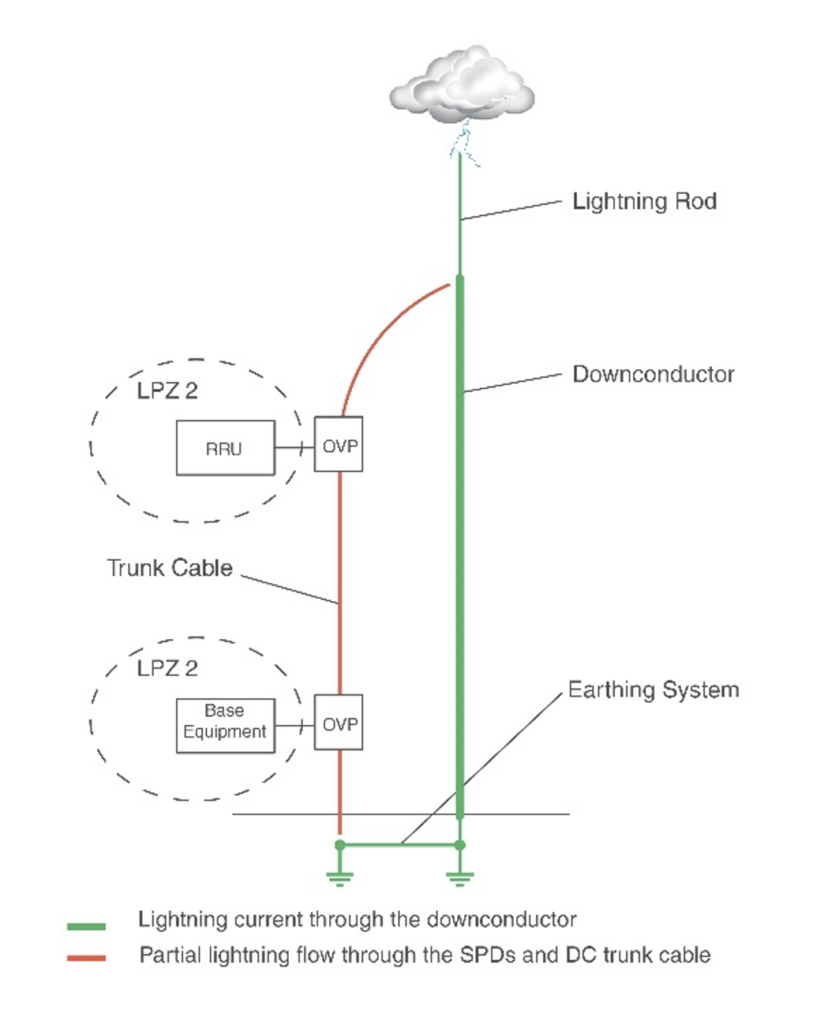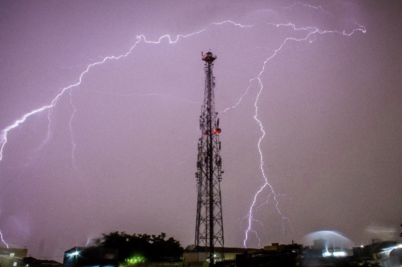By Tony Surtees, Vice President, Engineering, Raycap
Changing weather patterns and the growing frequency of abnormal storm activity increase the need for cellular sites to have the best available electrical protection. With Remote Radio Heads located on towers and rooftops and connected to base shelter equipment by long low-voltage DC power cables, the susceptibility to lightning-induced failure is amplified.1 When lightning strikes near the site, its electromagnetic pulse induces destructive overvoltages onto the DC trunk cables. This can damage the sensitive electronic equipment at either end of the cables if that equipment is not protected.
Lightning Protection Systems (LPS), as defined in NFPA-780 and IEC-62305 industry standards, consist of a strike receptor, a lightning down conductor, and a low-impedance ground termination system. The IEC 61643 standard covers the installation of overvoltage surge protection devices (OVPs) needed to safeguard sensitive electronic equipment. An LPS coordinated with an OVP system creates the highest level of electrical defense for cellular sites by reducing the effects of both direct and induced lightning events.
The lightning protection standards also deal with risk management and its mitigation. They provide methods to evaluate and consider the risk of damage and loss at a site. Various models are used to assess the risk based on the local ground flash density, a site’s exposure, its location with respect to adjacent objects, the impulse voltage withstand of the equipment installed, and how important its loss would be.
These models are categorized as:
- L1, Loss of human life
- L2, Loss of service to the public
- L3, loss of cultural heritage
- L4, loss of economic value
Of these, L2 and L4 are most relevant to communication facilities.
While these models are useful in assessing the risk to a particular structure, they are only models to the first-order. For example, while the average annual ground flash density in a specific region may be low, the actual ground strike distribution during a particular time of year or even a specific storm, may be much higher.
Changing climate patterns appear to be contributing to more frequent and severe thunderstorms, and an increase in the intensity of localized lightning activity.

The IEC 62305 series of standards introduce the principle of “Lightning Protection Zones”, or LPZs, where the threat level of progressively inner zones is reduced by intentional measures. For example, the first level of threat is reduced from LPZ0 to LPZ1 by deploying an LPS to divert the direct lightning strike to ground. The threat level at LPZ1 is then further reduced to LPZ2 by installing appropriate Surge Protective Devices (SPDs) which serve to minimize the risk of over voltages damaging the sensitive electronic equipment installed within this zone.
The IEC 61643 standards specify that the SPDs used to create the lower LPZ 2 threat level “must be suitable for the electrical environment to which they are exposed.” For example, an SPD that meets Test Class I is suited to divert direct lightning current, while an SPD tested to Test Class II can only handle the induced effects of lightning. Raycap‘s proprietary Strikesorb technology is specifically designed for the protection of telecommunication equipment and is able to meet both the Class I and the Class II test standards. As such, it can produce the LPZ 2 where sensitive electronics must be located.
Citations:
-
D. M. Kingfield, K. M. Calhoun, K. M. de Beurs. Antenna structures and cloud-to-ground lightning location; 1995–2015. Geophysical Research Letters: 44 (10) (2017), 5203–5212.
-
D. M. Romps, J. T. Seeley, V. David, M. John. Projected increase in lightning strikes in the United States due to global warming. Science: 346 (6211) (2014), 851–853.




Reader Interactions